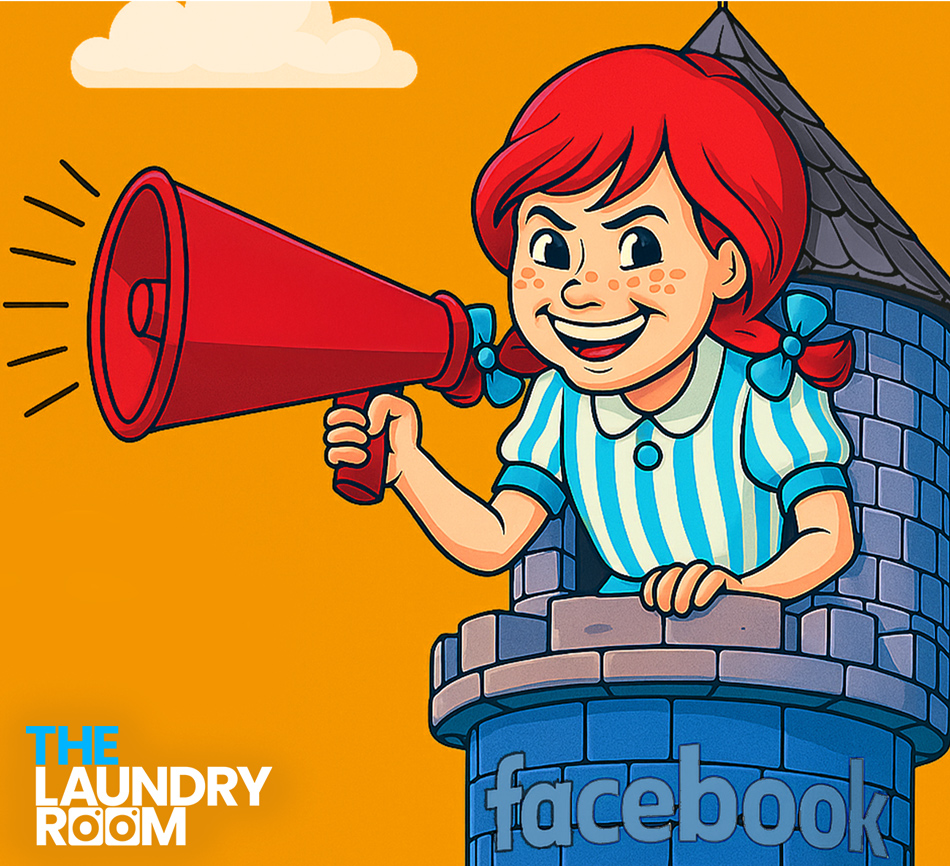00:06 – 00:45
We’re back at it again. I’m Nick Skislak.
I’m Michael Taylor.
We are at the beautiful SSDM headquarters in Troy, Michigan. And…
This is The Laundry Room.
This is The Laundry Room. Mike, what are we talking about today?
We’re four episodes in, four recordings in. All right, yep, and we want this show to partly be a revealing of what’s happening in the minds of people that work in the agency space,
00:46 – 01:13
what’s happening in the world of client interaction. We also, though, want to talk about some very practical things that should be happening in your marketing.
And so we’ve been talking a lot about lead nurturing, and what happens post conversion. We do a lot of work as an agency in lead generation, and being relevant to the right audience or consumer group that you’re trying to get in front of.
01:13 – 01:40
But what’s happened the last few years is the conversation from client of, I got all of these leads, I got all of these prospects that say they are interested in what we’re doing, but I’m not closing business.
So I have a CRM or a spreadsheet, an email box with people who I’m trying to get a hold of, or people that I’m trying to sell to, and it ain’t working.
01:40 – 02:08
So what should I be doing? So lead nurturing.
I think in the world of, or in the conversation of prospecting, what does, what should lead nurturing activity look like?
I’m excited about this, because this is the first time we’re going to get into kind of the importance of something that people could be doing. So some, this one I am excited about, because I think there’ll be some takeaways that people can take and start implementing and doing. And with nurturing
02:08 – 02:32
today, it’s virtually wide open.
Most don’t do it. They don’t understand the value of it. They don’t realize how little work it is, too, with using technology to do this stuff.
It’s not a heavy lift anymore to do this. They’re still doing it the old way, which is a heavier lift, which isn’t really getting the results that they’re looking for.
02:32 – 03:05
So, yeah, I’m excited.
So, maybe a good way to tee this up is looking at five reasons why your company, particularly B2B companies, the importance of why you should be doing some type of lead-nurturing activity, what that looks like, and how it would benefit the business. Now, for marketers, the, I think, old way of looking at it is it’s my job to wave the flag of our brand,
03:05 – 03:40
my job to get the attraction of people that are in our market. Sales team, it’s your job to close them.
I got them to you.
Yep.
I got them. You don’t know how to close biz.
What are you doing with them?
Yep.
Yeah. And so the, it’s interesting. You’re seeing this at all levels of organizations, small organizations, really large organizations, where that CMO or marketing leader role is being absorbed or merged with that of the sales leader.
03:40 – 04:09
So you have more revenue officers or growth.
Chief revenue officer is the new.
Yeah. Or growth officer. And I think it’s because finally organizations are realizing that the two are so intertwined.
They are so codependent. And the consumer, we as consumers today, we’re more savvy. We have higher expectations.
We have more needs in that buying process.
04:09 – 04:49:
There’s more visibility on both sides now. So to have something that you’re doing post-grabbing attention, that is, you’re right, it’s wide open.
Most organizations are still not doing that at all. And the ones who are, maybe not that effectively.
And I think what is important to know before we kind of get into what it is and what we should be doing, to kind of shine some light on what the most common thing is. And this is probably going to be the people listening, that it has historically worked, as you described, of marketing team
04:50 – 05:20
generates an inquiry or generates a lead. And it immediately, in hopefully less than 60 seconds, gets into the hands of a salesperson to outreach that lead.
Either phone call, email, perhaps a text, though we don’t see a lot of that, but primarily phone call. So marketing team invests this money, gets this web traffic or whatever, traffic in any form.
05:20 – 05:50
They provide inquiries or what many organizations call leads that are instantly handed over to sales squad.
And with today, sales squad isn’t having the success of connecting using the mediums, primarily the phone, to connect with these leads. And when they don’t do that, the lead goes away or is unqualified or is deemed junk. And that’s that.
05:50 – 06:28
So that is where you get the friction between sales and marketing. Sales says marketing generates a bunch of junk leads. Marketing says we’re generating great leads.
Sales doesn’t know how to close them.
Sales doesn’t know how to close them. Both bad attitudes, wrong, not the way to do it.
So certainly in a B2B space, but I think in most consumer transactions now, one reason why organizations should be doing lead nurturing activity is because those leads or prospects, they’re not ready to buy yet.
06:28 – 07:07
They are shopping, tire kicking, but they are not ready to buy. In fact, one statistic says that only 2% of sales occurs in the first meeting, the first conversation.
Only 2% of those conversations are actually closing in that first meeting. And depending on the severity or bleeding neck, if you will, of the prospect, I got to have this thing right now, that has some weight in this stat, right?
07:07 – 07:36
You have a flooded basement, our favorite analogy.
Basement’s flooded, I need a plumber right now. Bleeding neck is, it’s not going to take a lot of touch points, a lot of back and forth between person who has the basement flooded and the plumber. You likely are going to get that pretty quickly.
But you know, B2B, where there’s a lot of education that has to happen, there is a sophisticated journey for that consumer,
07:36 – 08:02
they’re not going to buy after that first meeting. In fact, they don’t even want to talk to you in their first call.
That’s the biggest kicker. They don’t want to talk to you. They want to do, what was it, 80% of their research independently, alone, by themselves, online, before they talk to anybody.
So if your first outreach, which I do think speed to lead is important, calling the lead back right away is very important,
08:02 – 08:23
knowing full well that 90% of those phone calls are going to go unanswered. Stopping there is what the issue is. They don’t want to talk.
Take the hint. Other things need to happen. This isn’t a junk lead.
This isn’t unqualified. They’re not ready. And that’s the thing I think we’re all addicted to is this, like, give me another one.
08:23 – 08:48
Just give me another one. Give me another one. Give me another one.
And there’s a lot of money falling to the floor.
An analogy I like to borrow from, you know, the entertainment world is the cutting room floor, right? You have all of this activity that’s been done. Something’s fallen to the floor, and one moment it can be deemed irrelevant or not good.
08:48 – 09:05
But when you’re really getting to the end of what do we have, what do we have to show for this work, sometimes you look back on the floor, the cutting room floor, and say, wait a minute, that’s not as bad as I thought it was. There’s actually value in that. Leads are the same way.
These are people, right?
09:05 – 09:31
These are consumers who are somewhat, they’ve shown interest, so they’re somewhat in your market. It’s just a matter of identifying where they are.
So that alone, because you’re only closing 2% in that first meeting, you can’t abandon the 98%. There is more there left for the sales team or the marketing team, the revenue team
09:31 – 09:48
To grab. And what I think organizations struggle with, with the new buyer, right, with today’s new B2B buyers, wanting to do everything on their own, afraid to talk on the phone and meet with people, is
09:48 – 10:20
Giving the meeting the customer where they are? Yeah. Organizations are horrible at that. It’s either you meet me where I am or keep it moving. Yeah. Move on. Give me another one. And that is. Yeah, that that’s a really tough obstacle, I think, for organizations to get over.
So another reason for lead nurturing and why it’s so important, the authenticity, the rapport that you’re trying to create with that consumer,
10:20 – 11:03
so vital now. We have a ton of options when we are making a purchase. And I think for us, certainly as a small company that is employing people, have clients, when you think about the management of people, I can think of HR.
So who helps us with people management? That’s a big deal. Healthcare, phone system, the companies that another company would rely on to link arms and help me provide something for people.
11:03 – 11:37
So that decision, you don’t pull that trigger easily. And so one of the considerations is, how well is the rapport with this business? Are they authentic?
Do they get me? Do I get them? Do I like them?
Outside of the product or service that they’re offering, do I want to do business with you? So that lead nurturing allows you to shed light on who you are as a company to that prospect, to hopefully build the authenticity, the relationship, the rapport, to push them down
11:37 – 12:08
that purchase funnel. And that is often forgotten, because it is a, hey, this isn’t a first date.
This is, we’re at the altar, man. I’m ready to get married right now. And customers saying, I don’t even know you yet.
Well, and that’s the thing too. We see a lot with, you know, certainly first timers. When you start doing things to generate consistent leads off the web, these leads are much different than the leads your sales team is generating you.
Sales team based on network and referrals.
12:08 – 12:30
So the courtship, if you will, for those leads is much easier, much smaller. It’s arranged, you’re vouched for.
When you’re on the web, they don’t know you. They don’t know who you are. They don’t know what you do.
Yeah, you talk about a lot of things about yourself on the website, but that’s not the validation they need to do biz.
12:30 – 12:53
And it’s a much different process of what you’re getting, what your sales team is driving you versus what your web is going to get you.
Right, right. Third, I think there is, because we live in a microwave world now, everything is not wanted right now, but I’m going to forget it 24 seconds from now,
12:53 – 13:20
you have the ability to stay top of mind. So you could have a great first interaction with a prospective client.
Meeting goes well. We have this happen all the time. We have a great meeting with a client, a would-be client, and then it goes dark.
You send an email or a text, and they’re not reaching back out.
13:20 – 13:57
They haven’t signed the proposal you might have put in front of them or at the purchase order or the contract. And what do you do?
You set the salesperson, sends an email to the prospect, and says, hey, just checking in.
Just checking in.
Seeing how the proposal is coming along.
Right. And it’s a… Instead, that lead nurturing gives you now an additional voice, an additional chance to have a conversation about other intangibles that might matter in that purchase decision.
Be it,
13:58 – 14:26
here are things that will also benefit you from this purchase. Here’s some examples of how it’s benefited others. Here’s how we are leading in our space, in our industry.
Here’s how we sell this to leadership. Yeah.
Arming them with the information that they need to make a good decision. They can’t retain that from one interaction that you had at the initial meeting.
14:26 – 14:53
So there has to be some…
Or verbal communication.
Right. So it’s a great chance for them to still have the control. That’s what we want as consumers.
I want to control what I buy, when I buy it, how I buy it. But keeps you in their pocket. Now you are top of mind.
Giving them the intel that’s going to help you close them as a prospect.
14:53 – 15:15
That’s the biggest thing I’ve been fighting with clients as of late, is to kind of build up their sales squad in that I always say, I would love it if people saw a video of me before they met me. Even this. I hope people watch the podcast before they actually talk to meet us.
Because we’ve already done,
15:15 – 15:35
they must have liked it if they’re willing to take a meet, right? But we’re validating ourselves before, but just as important in what we’re talking about is validating yourself after. If you have a 20-minute call with Jeanette, the salesperson, wouldn’t it be, and then you know, it’s a great call and then you get ghosted.
15:35 – 16:05
Wouldn’t it be nice to know a little bit more about Jeanette’s expertise in your industry, working with clients like you and just all the things that you said, and none of that, no. And we said this morning, it’s not no one’s doing this. Most are not doing this.
This is a wide open opportunity for organizations, and we’re talking emails, automations, email automations, text automations that can keep you, to your point, keep you top of mind. And there for them.
16:05 – 16:30
And that’s the tough part.
Maybe the salesperson calls once a month, just because that’s what they do. That’s cool, that’s good. But a sales guy calls them four times in 48 hours, doesn’t get, this is what’s happening today.
Business reaches out aggressively. Call it. And everybody’s on the, hey, we got to touch them 12 times, or we got to touch them 22 times.
16:30 – 16:51
Well, you tell a sales guy that, they’re going to get your touches in, but are they going to be the most effective touches? Absolutely not. This guy’s going to call eight times in 24 hours, and then bring the lead back to marketing and say, junk lead.
And that’s the hiccup.
One example, you remember me talking about this last year.
16:51 – 17:22
I was enamored by how I was being nurtured. I’m reaching out to a financial advisor, and this company, this guy, his lead nurturing activity was so gangster.
I mean, he was, I am a fan. I’m not a customer either. I’m not a client.
I am such a fan of the work that they put into their lead nurturing.
17:22 – 17:42
I had a really good first call. He walked me through, this is what we do, this is what it means for you, this is what it means for us, to help you try to achieve whatever goals you have.
I wasn’t ready though. I’m just shopping. I’m just trying to get some info.
You took a meet.
17:42 – 18:03
Took a meeting, and I ghosted him. And I was getting an email every two days. And then it went dark for a little bit.
I read every email. Every email was great. It was informative.
It kept him top of mind for me. So I’m thinking about what these guys do. And…
Did they have next steps in them?
18:03 – 18:24
Oh yeah.
Everyone had a call to action? That’s just to interject really quickly. In the nurturing process, we see that as a fail many times as well.
Where there’s these follow up drip campaigns, there’s no offer made. Hey, this is what we’re doing. This is what’s going on.
Not having an offer or a next step for clients
18:24 – 18:50
is so crucial to these things.
Keep going. So that was, call it, two months’ worth of emails, text messages that I was getting. Then it tapered off.
So they did a good job of identifying, all right, this guy is farther out in his decision than maybe we thought. We’ve identified that, and it tapered down.
18:50 – 19:16
But then six months, I started getting emails again, and it shifted to more of, hey, here’s why you should be considering having this type of support.
It wasn’t hard sales, right? It wasn’t a…
Well, financial advising is important.
Yeah, and it’s a, you know, in that first interaction, they did a good job of locating where I was.
19:16 – 19:43
Okay, he’s married. Oh, you got three girls.
All right, cool. Man, you got three girls. That means you have three weddings.
Yeah, right.
Oh, man, those kids probably want to go to school. You know, you got a plan for that? What does that look like?
And it was very relevant. So six months later, for him to circle back with content that mattered to me, right?
19:43 – 20:10
So if and when I pull the trigger, he’s top of mind.
He’s going to be on my short list to reach out to.
And that’s, what, eight months?
Oh, yeah, nine months into it. What did it save him? He doesn’t have a salesperson calling me every two days.
That’s wasted activity. That salesperson can now go focus on someone who’s ready to buy.
And wait for you to come back
20:10 – 20:32
when you’re ready. Meet you where you are and be there in your way. When you’re ready to talk, you’ll call.
And they’ll be there. Yeah, that’s good.
And that leads me to next reason. The majority of your competition isn’t doing this. Why should you be lead nurturing?
The majority of your competition isn’t doing this at all.
20:32 – 20:59
And the ones that are is very much a short time period, heavy frequency, and then gone. That’s it. So the ones that are doing it aren’t doing it very well.
And there is no one size fits all in lead nurturing. You have to really curtail. And that’s really the awesomeness behind it as well.
20:59 – 21:22
You can fashion it so that it is in step with that of what you’re selling, what your product offering is, what your service offering is to really understand. And then this opens up a whole world of, all right, what is our sales cycle? How long does it take us to sell?
If you ask a salesperson based on their referral network,
21:22 – 21:48
oh, yeah, I’m closing somebody in two weeks. Well, yeah.
50% to 60% close rate.
But you’re not accounting for all the time that was spent in building that rapport with that referral network. Someone cold who doesn’t know who you are that reached out. What is that sales cycle?
I think for people, too, with this lead gen thing, where it gets a little freaky for them, it starts to become daunting.
21:48 – 22:09
Like, oh my gosh, this is humongous, because we have customers like this, we have customers like this, and we have clients. You gave the daughters example as, okay, I’ve got daughters, that’s three weddings.
Then you said daughters, school. So me in my head, I’m like, oh my gosh, these are all different funnels now that I have to…
Have content for?
22:09 – 22:38
Yeah. No, you don’t. Would it be great if you did?
Absolutely. Build it. But I think getting to that first base for clients is the most challenging part.
It doesn’t have to be this super elaborate 150 email spread across 10 different funnel thing. Just start. Start with one.
What is happening to the inquiries and leads that you get that you never communicate with?
22:38 – 22:54
What are you going to send them? What happens to the next step?
What happens to the leads that come in? You have a good conversation and then you get ghosted. There’s your two funnels.
And maybe start with the talk, no talk. First you talk, have a good meet, and then you get ghosted.
22:54 – 23:13
What do you want to say to them in the next eight months?
What is the position that you want to have in their mind? What is the frequency required to get that? And over a decent, like you said, he’s been engaging with you for almost a year.
I’d be curious to know if it goes a year.
23:13 – 23:43
I hope it does. But that’s the big, big piece when you talk about marketing and nurturing.
The effects that nurturing has on your inquiries is amazing.
Yeah, so the fact that your competition is likely not doing it, now it increases your ability to stand out. And that’s where all of these reasons are interconnected,
23:43 – 24:12
because here you are trying to foster some type of relationship, authenticity. You’re trying to stay top of mind so that they answer your phone call when you reach out.
You want to make sure that you’re not abandoning the 98% that is not closing from that first interaction. All of these things are intermingled, where just by virtue of doing it,
24:12 – 24:42
you’re right. And that’s probably the first step, right?
Taking the first step of, let me write one email that I can have in my sales kit that automatically gets sent out after my meeting and see what that does. And then you iterate, iterate, iterate. Salesperson is the most important person in an organization, arguably, right?
They have a lot of insight about what a customer cares about,
24:42 – 25:16
what the objections are, what the concerns are. And a big miss that we see as marketers is that’s not being funneled back through the marketing team or in our marketing. You have all of these insights that you know as a sales team about our customer, marketing can leverage that.
That’s ammunition now. Pull it to the front so that we can arm consumer with all the things that they need to make a good decision, to have us on their list of consideration.
25:16 – 25:36
And that makes the job of the salesperson easier now because now you can focus on here’s who we are as a company.
This is why you becoming a client or buying from us is going to matter for you. And it is more of an authenticity play, relationship play than it is a hawking sales or I got to make my 100 calls today.
25:36 – 25:56
Your call number 43, right?
No, now it’s let me focus on the people who they’ve already put us on their list of consideration. They just need to know that we’re human and that we care about what their pain is, what their challenge is, and we can help them solve it. That is, most of your competition is not doing that,
25:56 – 26:40
so you should be.
The, it’s funny, as an agency, we have, we are fortunate, like other companies, to benefit from referrals, right? And so we were sometimes, certainly you, were hard on ourselves about what are we generating new, new from our marketing efforts. New, new.
And so this is us preaching to the choir a little bit. I think we are, we’re equally in that space of how do we nurture? How do we create that top of mind content that allows someone in our funnel to deem us relevant, deem us credible,
26:40 – 27:00:
deem us authentic?
Without the use of your sales team. That’s the kicker. Because you hire sales guys and you instantly look at them and go, this guy’s going to make me money.
He’s on the rev side of the balance sheet. Guy’s going to make you money. Well, you just tied up one of his hands behind his back.
27:00 – 27:23
In today’s buying world, he’s not as effective, very much needed. And when I say effective, I mean way of communicating, which this is not the thing anymore. It cannot be solely phone and sales guy hammer and leads away.
It’s got to be meeting people where they are and giving them content the way they want to consume it.
27:23 – 27:41
And that’s the hard thing to get over. Because for a lot of these guys too, the sales game, the way they’ve been doing it, has worked.
And now it’s like, well, what’s happening? What’s going on? I could get a sales guy, train him in six months, and he’d be net positive for me.
27:41 – 28:12
Now, it’s taken him a year.
Yeah. Good segue into the fifth reason why you should be lead nurturing. And I’m still a little floored when you share this with me.
That more deals in the long term for companies, right? Companies that are doing lead nurturing generate 50% more sales ready leads than companies that are not.
28:12 – 28:39
And they get those leads at a 33% less cost.
This is what is perplexing to me about sales guys that fight us. You know, I switch. Sometimes I act as a sales guy, and then sometimes I act as a marketing guy.
Right now, I’m acting as a marketing guy. What perplexes me is sales people that are, like I hear that, and there’s still a lot of sales people out there that are reluctant to let go of the reins.
28:40 – 29:00
No, no, no marketing.
You can’t. This is relationship building. You guys can’t do this.
Thank you for the lead. Step out of the way. No.
If I was a sales guy out in the world today, I would be embracing marketing. I would say, what else, guys? What else you want from me?
You want me to do a podcast every day?
29:00 – 29:30
You want videos every day? I would much rather, as a sales guy, lean on marketing to fill my pipeline rather than me having to do it.
I’d love, why not sit back and get leads brought to you that are ready and qualified rather than hammering away at unqualified, unknown, that you have no idea where they are, what they’re planning to do, but you’re hounding these leads to try to get sales.
29:30 – 29:52
I would much rather do this, give it to marketing, let them promote it, and then bring them to me. That’s what I find interesting about this.
It’s maybe an ego thing, maybe fear is part of that too, of letting go and unknown. What is this? What are we doing?
No doubt about it.
29:52 – 30:18
What are you talking about, video? I don’t want to be on video. Or emails.
My clients don’t open emails. Our clients don’t go on social media. You know, you hear all that stuff.
No doubt about it. The unknown, unknown, unknown.
Yep, the unknown, unknown.
And there is, and maybe that is the wrap up of this list.
30:18 – 30:38
Why does this list even matter? Why does lead nurturing matter?
And why is it so hard for companies to take a stab at it? They don’t know. It’s scary.
They haven’t done it. A lot of companies exist that aren’t doing a lot of marketing, and they’re very successful.
You don’t know what lead nurturing is. It doesn’t matter.
30:38 – 31:06
Just do it.
That’s the message. Don’t understand it. It’s okay.
Feels weird. Feels foreign. It’s okay.
Just do it. Just do it anyways. That’s the take away.
You got that, Magnus? Just do it. All right.
Just do it.
Well, look, I think another conversation that we’ll have out of this one will be, how do you start?
31:06 – 31:37
What are some very right now things that you can do? What are tools that you can tap into to arm your teams in doing this?
It’s not as daunting. It doesn’t require going and getting the biggest and baddest platforms out there to do it. There are some very practical solutions that can help with this.
And so maybe we even provide that in our link when people are reading about this episode, and we can talk more about that.
Cool.
31:38 – 31:44
Well, thank you, guys. Another episode.
Have a great day. This was great. Thank you, Michael.
Thank you, man. See you next time.

















